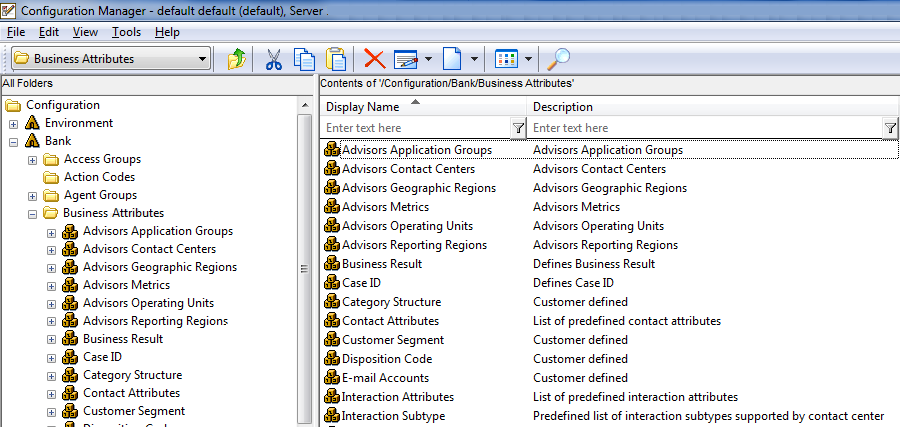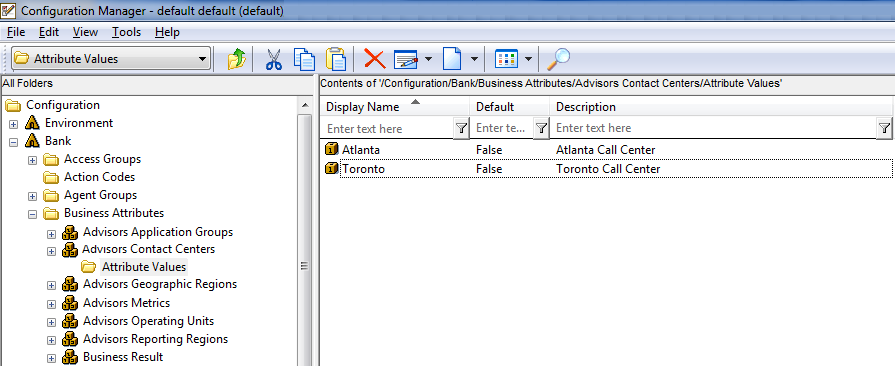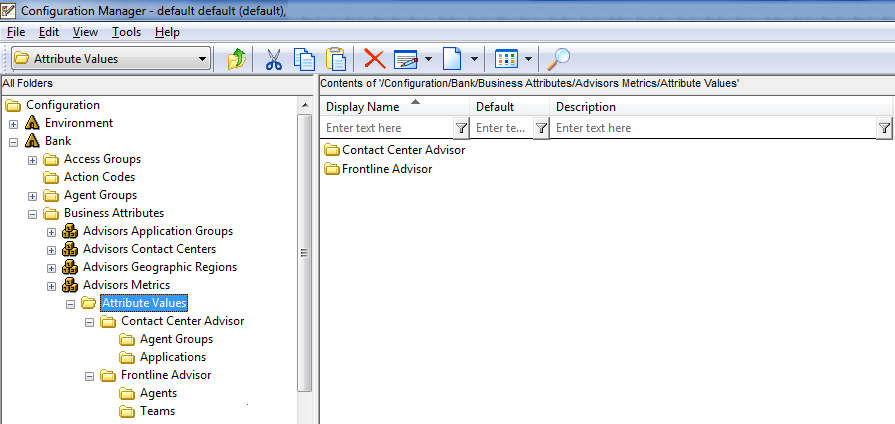Contents
Advisors Business Objects
All user profile functions and role-based access are handled in Configuration Server. To be able to fully complete the configuration of an Advisors installation and perform administrative functions, you must have access to the Genesys Configuration Manager. Business objects (reporting regions, geographic regions, operating units, contact centers and application groups) are:
- Created initially in the Genesys Configuration Manager under a single tenant as business attributes
- Subsequently configured to completion in the Advisors Administration module.
- Deleted only in the Configuration Manager (although it can also be removed from Advisors).
The Genesys Configuration Manager database is the master record holder for these Advisors business objects. Consequently, all create and delete functions are performed in the Genesys Configuration Manager. Metrics are created by the Platform database, and configured in the Advisors Administration module. You use Configuration Manager to assign permissions to access groups and to persons to determine whether the users can see the metrics in the Administration module and in the dashboards. Deleting a metric from the Configuration Manager does not delete it from Advisors, but does hide it in any functionality that would otherwise show it. Objects (other than metrics) can be made active or inactive in the Advisors environment. The following screenshot shows the Advisors business attributes in Configuration Manager.
Agent-group contact centers are not configured in the Configuration Manager. They are added as children of network contact centers during network contact center configuration on the Advisors side. All users that have permissions to see network contact centers are allowed to see the whole set of the related agent-group contact center. Users are configured entirely in the Configuration Manager. There is no user configuration functionality in the Advisors Administration module.
Starting in Release 8.1.5, the master list of filters for Advisors (for CCAdv, WA, or FA) no longer comes from the Stat Server configuration, but from the Configuration Server. Advisors Filters is added to the Advisors Business Attributes section of the Configuration Manager (see the following screenshot).
The Advisors Filters business attribute must exist on one – and only one – tenant. Genesys recommends you configure the Advisors Filters business attribute on a tenant that is the default tenant for the Advisors suite installation, on which you configure all Advisors metadata. If there are Advisors Filters business attributes configured on multiple tenants, you receive an error message on the Genesys Adapter installation and the filters are not loaded.
If filters are associated with configured objects on the Base Object Configuration page in the Administration module, the filter and object combination is stored on the Annex tab of the object’s Properties window.
Advisors metadata elements (business objects and metrics) are not represented as standard objects in Configuration Manager. The business attribute values contain just the ID and name of the metadata object. You can enter a description for a business attribute in the Configuration Manager, but Advisors does not import it into the Advisors database, or use the description in any other way.
These objects are then synchronized with the Advisors database, and the administrator can then configure the remaining information for each object along with the necessary relationships by using the Advisors Administration module.
Under each Configuration Manager business attribute, there is a folder that contains the list of attribute values. These attribute values represent the individual objects for this object type. For example, if there are two contact centers (Atlanta and Toronto) being configured in CCAdv, the Configuration Manager metadata would look as follows:
Creating an Advisors Object as a Business Attribute in Configuration Manager
When creating an Advisors object as a business attribute value in Configuration Manager, the following fields are required. Name, Type and Tenant are mandatory for completing the new object in Configuration Manager.
Name: For metrics, this field is a concatenation of [Application].[ObjectType].[Channel].[Name]. For more information, see Configuring Metrics. This name does not represent the name displayed for this metric on the dashboard, which can be configured on the Advisors Administration Metric Manager page. For CCAdv hierarchy objects, this field represents the name of the object, and is the display name.Tenant: The tenant to which this Advisors object belongs. This value is set when the Advisors Platform is installed, and cannot be changed.Type: This is alwaysCustom. Once set, the value cannot be changed.Description: A simple description of this object. For a filter, enter the filter expression in theDescriptionfield. This description is used only in Configuration Manager. This is not the description used for the object in the Advisors application.
Name field cannot be changed.Required Permissions
To create a business attribute, you must have Create permission with respect to the business attribute folder or sub-folder in which the object will reside. Create permissions are configured for you by a super administrator.
Deleting an Advisors Object from Configuration Manager
Genesys recommends that you do not delete Advisors objects from Configuration Manager until all their interdependencies and relationships in the Advisors-side configuration have been correctly processed.
Required Permissions
To delete a business attribute, you must have Delete permission with respect to the business attribute folder or sub-folder in which the object resides.
Synchronization
When a new object is created in the Configuration Manager and saved, it is automatically propagated to the Advisors environment and appears in the Administration module marked as not configured and inactive. Its remaining attributes must be configured in the Advisors Administration module. Once this configuration is complete, the object is available and can be used for rollups. Changes made on the Advisors side are not stored in the Configuration Manager.
Configuring Metrics
Metrics are handled differently from other Advisors business objects. Because metrics for CCAdv, WA and FA are stored under the Advisors Metrics business attribute, a folder structure has been created to segment the metrics for each application and for each object. See the following screenshot.
Each application’s metrics are created under the appropriate folder, and are subdivided by the object types they are associated with. For example, there could be an AHT for applications and an AHT for agent groups in CCAdv. There would then be an AHT business attribute value under Contact Center Advisor/Applications and another one under Contact Center Advisor/Agent Groups. This allows the control over which users have access to specific metrics at a very granular level; a user could be given access to the AHT metric for applications but not for agent groups. To avoid confusion over similarly named metrics, and because Configuration Manager does not allow duplicated names for attribute values, the names of the metrics are name-spaced and case sensitive. The format of the name-space is: [Application].[ObjectType].[Channel].[Name] where:
- [Application] —Can be FrontlineAdvisor, WorkforceAdvisor, or ContactCenterAdvisor.
- [ObjectType] —Represents the object type associated with this metric. This could be AgentGroup, Agent, Contact Group, Application, or Team.
- [Channel] —Can be Email, WebChat, Voice, All or AllNonVoice.
- [Name] —The name of the metric.
For example, the AHT for agent groups in CCAdv would have the following name: ContactCenterAdvisor.AgentGroup.Voice.AHT An FA metric could have the following name: FrontlineAdvisor.Agent.Voice.nch_1 FrontlineAdvisor.Team.Voice.taht_2
The Display Name field of the metric business attribute has only a copy of the business attribute’s name.




